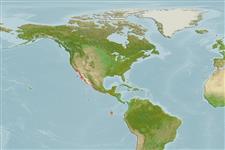>
Anguilliformes (Eels and morays) >
Muraenidae (Moray eels) > Muraeninae
Etymology: Gymnothorax: Greek, gymnos = naked + Greek, thorax, -akos = breast (Ref. 45335).
More on author: Ayres.
Environment: milieu / climate zone / depth range / distribution range
Écologie
marin démersal; profondeur 1 - 40 m (Ref. 35581). Subtropical; 34°N - 2°S, 121°W - 90°W (Ref. 96339)
Eastern Pacific: Point Conception in California, USA to southern Baja California in Mexico. Also known from the Galapagos Islands (Ref. 35581).
Taille / Poids / Âge
Maturity: Lm ? range ? - ? cm
Max length : 152 cm TL mâle / non sexé; (Ref. 2850); âge max. reporté: 30 années (Ref. 56049)
Description synthétique
Clés d'identification | Morphologie | Morphométrie
Épines dorsales (Total) : 0; Épines anales: 0; Vertèbres: 146 - 154.
Found common among rocks; lives in crevices or holes, usually with only head protruding. Very common in shallow reef areas (Ref. 35581). Feed mostly at night on crustaceans, octopuses and small fishes. Long-lived. Pelagic spawners (Ref. 56049).
Life cycle and mating behavior
Maturité | Reproduction | Frai | Œufs | Fécondité | Larves
Oviparous. Pelagic spawner (Ref. 56049).
Eschmeyer, W.N., E.S. Herald and H. Hammann, 1983. A field guide to Pacific coast fishes of North America. Boston (MA, USA): Houghton Mifflin Company. xii+336 p. (Ref. 2850)
Statut dans la liste rouge de l'IUCN (Ref. 130435: Version 2024-2)
Menace pour l'homme
Traumatogenic (Ref. 4690)
Utilisations par l'homme
Pêcheries: pêcheries vivrières; Aquarium: Aquariums publics
Outils
Articles particuliers
Télécharger en XML
Sources Internet
Estimates based on models
Preferred temperature (Ref.
123201): 18 - 28.3, mean 25.3 °C (based on 18 cells).
Phylogenetic diversity index (Ref.
82804): PD
50 = 0.5000 [Uniqueness, from 0.5 = low to 2.0 = high].
Bayesian length-weight: a=0.00048 (0.00025 - 0.00091), b=3.28 (3.12 - 3.44), in cm total length, based on LWR estimates for this Genus-body shape (Ref.
93245).
Niveau trophique (Ref.
69278): 4.5 ±0.8 se; based on diet studies.
Résilience (Ref.
120179): Faible, temps minimum de doublement de population : 4,5 à 14 années (tmax=30).
Fishing Vulnerability (Ref.
59153): Very high vulnerability (90 of 100).
